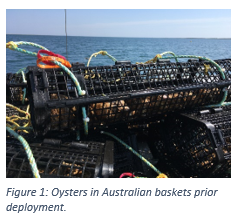AQUACULTURE DIVERSIFICATION: OPTIMIZATION OF GROWTH PERFORMANCE AND TECHNICO-ECONOMIC ASSESSMENTS FOR OYSTER AQUACULTURE DEVELOPMENT IN MAGDALEN ISLANDS, QUEBEC
Shellfish aquaculture diversification is essential to ensure rentability and sustainability of shellfish farming activities worldwide, and more specifically for small-scale industries developed in local coastal areas such as Magdalen Islands (QC). Magdalen Islands have a subarctic oceanic climate and are composed of multiple shallow coastal areas and lagoons where the seawater temperature is expected to increase with global warming. As such, local farmers, farmers that were predominantly growing mussels, have recently taken up oyster faming of the American oyster (Crassostrea virginica) due to its high potential market value and positive outlook. However, one of the short-term challenges faced by the new oyster farmers is the adaptation of methods specific to their environment. This includes which type of structure, oyster density and antifouling techniques to use, but also how to evaluate growth performance and its economic value as a new activity. This study had 3 main objectives: the first objective aimed to identify the best method for oyster growth and fouling management. To answer this objective, oysters were placed for 2 years (2018-2019) in 2 structure types: a combination of pearl nets and lanterns, and Australians baskets. Structures were then deployed in Merinov’s site (lagoon) and 3 industrial partners’ sites (2 in lagoon, one in a more exposed area). During this period, various antifouling methods were used: air exposition and seawater power washing were applied at two frequencies (monthly and bimonthly), while oyster growth, mortality, and biofouling coverage were followed. The second objective aimed to identify what combination of oyster density, seeding size, and structure type was the most performant. Here, growth and mortality were followed over 2 years on individuals placed in 2 structure types (Australian baskets and pearl net/lanterns), at 3 initial densities and at 2 seeding sizes on Merinov’s site (lagoon). Interestingly, the bi-monthly air exposition technique was the most efficient on biofouling but also had the largest impact on growth. Finally, the last objective was to develop a techno-economic model for oyster farming production and its application within the Magdalen Islands context. The advantages and drawbacks of each growing and management method as well as economic factors will be further discussed in the presentation.
